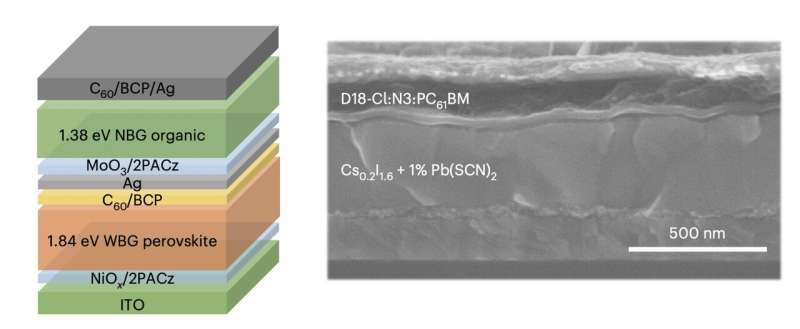April 28, 2024 feature
This article has been reviewed according to Science X's editorial process and policies. Editors have highlighted the following attributes while ensuring the content's credibility:
fact-checked
peer-reviewed publication
trusted source
proofread
A strategy to boost the efficiency of perovskite/organic solar cells

In recent years, researchers have been experimenting with a wide range of solar cell designs in the hope of facilitating their widespread deployment. Organic solar cells based on perovskite materials have been found to exhibit various advantages over conventional solar cell designs based on conventional silicon, including lower costs of fabrication, greater flexibility and tunability.
So far, organic solar cells have achieved a maximum certified power conversion efficiency (PCE) of 19.4%, which is lower than that exhibited by silicon solar cells. A proposed strategy to boost their efficiency and stability entails combining these cells with cells based on mixed halide wide-bandgap perovskites, creating perovskite/organic tandem solar cells.
While perovskite/organic tandem solar cells could theoretically achieve high PCEs and stabilities, their performance is hindered by a process known as phase segregation. This process degrades the performance of wide-bandgap perovskite cells and in turn adversely affects recombination processes at the tandem solar cells' interconnecting layer.
Researchers at Soochow University's Suzhou Key Laboratory of Novel Semiconductor-optoelectronic materials and devices recently devised a strategy to suppress phase segregation in wide-bandgap perovskites, thus boosting the performance and stability of perovskite/organic tandem cells. This strategy, introduced in Nature Energy, entails the use of a pseudo-triple-halide alloy incorporated in mixed halide perovskites based on iodine and bromine.
"Mixed halide wide-bandgap perovskites are suitable for integration in tandem photovoltaics such as perovskite/organic tandem solar cells," Zhichao Zhang, Weijie Chen, and their collaborators wrote in their paper.
"However, halide phase segregation originating from halogen vacancy-assisted ion migration in wide-bandgap perovskites limits the device efficiency and lifetime. We incorporate pseudo-halogen thiocyanate (SCN) ions in iodide/bromide mixed halide perovskites and show that they enhance crystallization and reduce grain boundaries."
The researchers found that the the introduction of their pseudo-halogen thiocyanate ions into iodine/bromide mixed halide perovskites prevented halide elements from separating inside the solar cells. Thiocyanate ultimately slowed down crystallization in, preventing the ions from migrating and thus facilitating the movement of electric charge in the solar cell.
"Trace amount of SCN ions in the bulk enter the perovskite lattice, forming an I/Br/SCN alloy, and occupy iodine vacancies, blocking halide ion migration via steric hindrance," Zhang, Chen and their colleagues wrote. "Taken together, these effects retard halide phase segregation under operation and reduce energy loss in the wide-bandgap perovskite cells."
To test the ability of their proposed strategy to suppress phase segregation in wide-bandgap perovskites, the researchers applied it to the development of a perovskite/organic tandem solar cells. In these initial tests, they found that the resulting tandem solar cells achieved a PCE of 25.82%, a certified PCE of 25.06%, and an operational stability of 1,000 h.
In the future, the methodology introduced by Zhang, Chen and their collaborators could be adapted and applied to more wide-bandgap perovskites with different compositions. This could ultimately contribute to the development of promising new perovskite/organic photovoltaics that are stable under varying light intensities, exhibit high PCEs, and can operate for longer periods of time before deteriorating.
More information: Zhichao Zhang et al, Suppression of phase segregation in wide-bandgap perovskites with thiocyanate ions for perovskite/organic tandems with 25.06% efficiency, Nature Energy (2024). DOI: 10.1038/s41560-024-01491-0.
© 2024 Science X Network

















